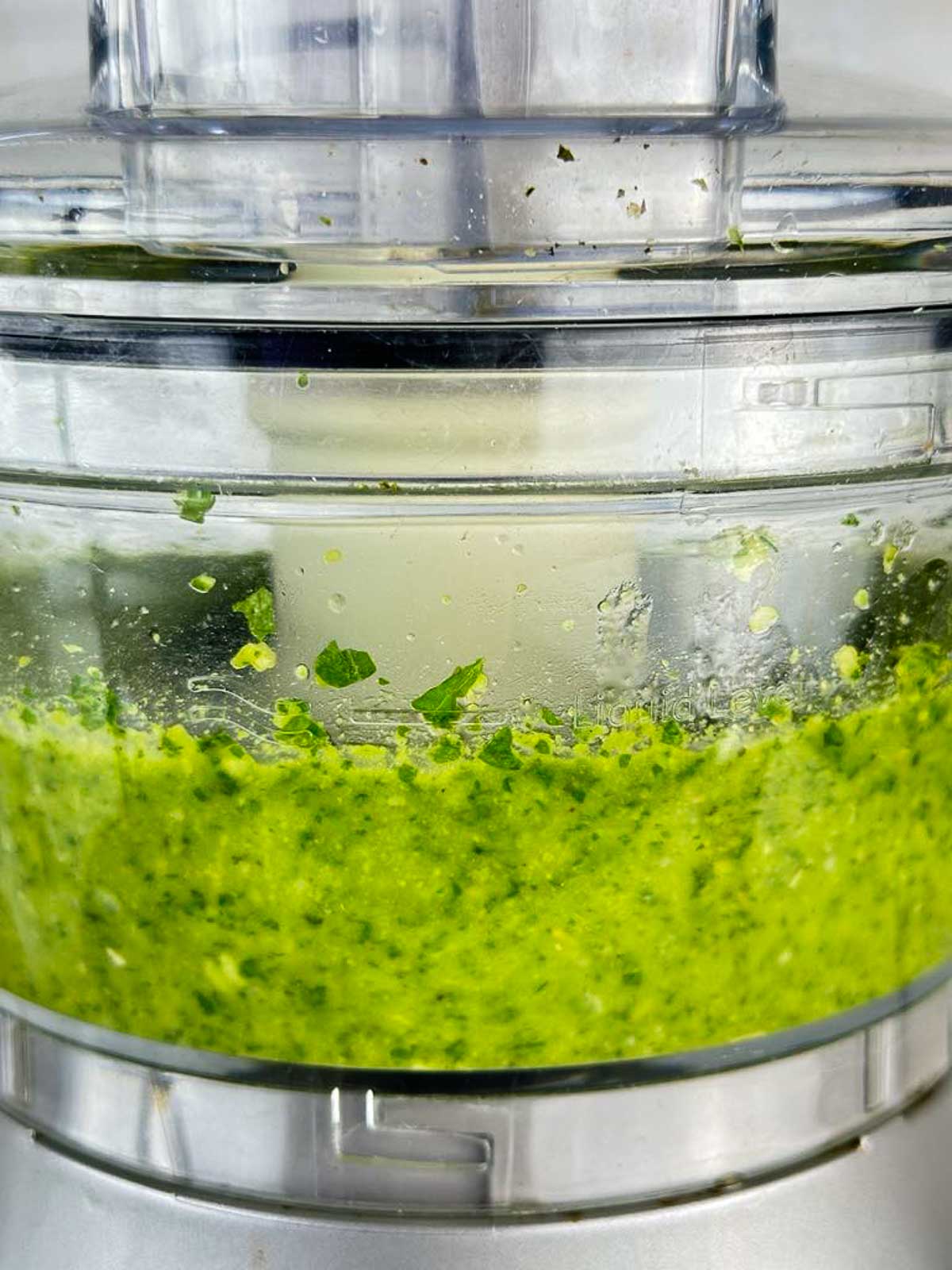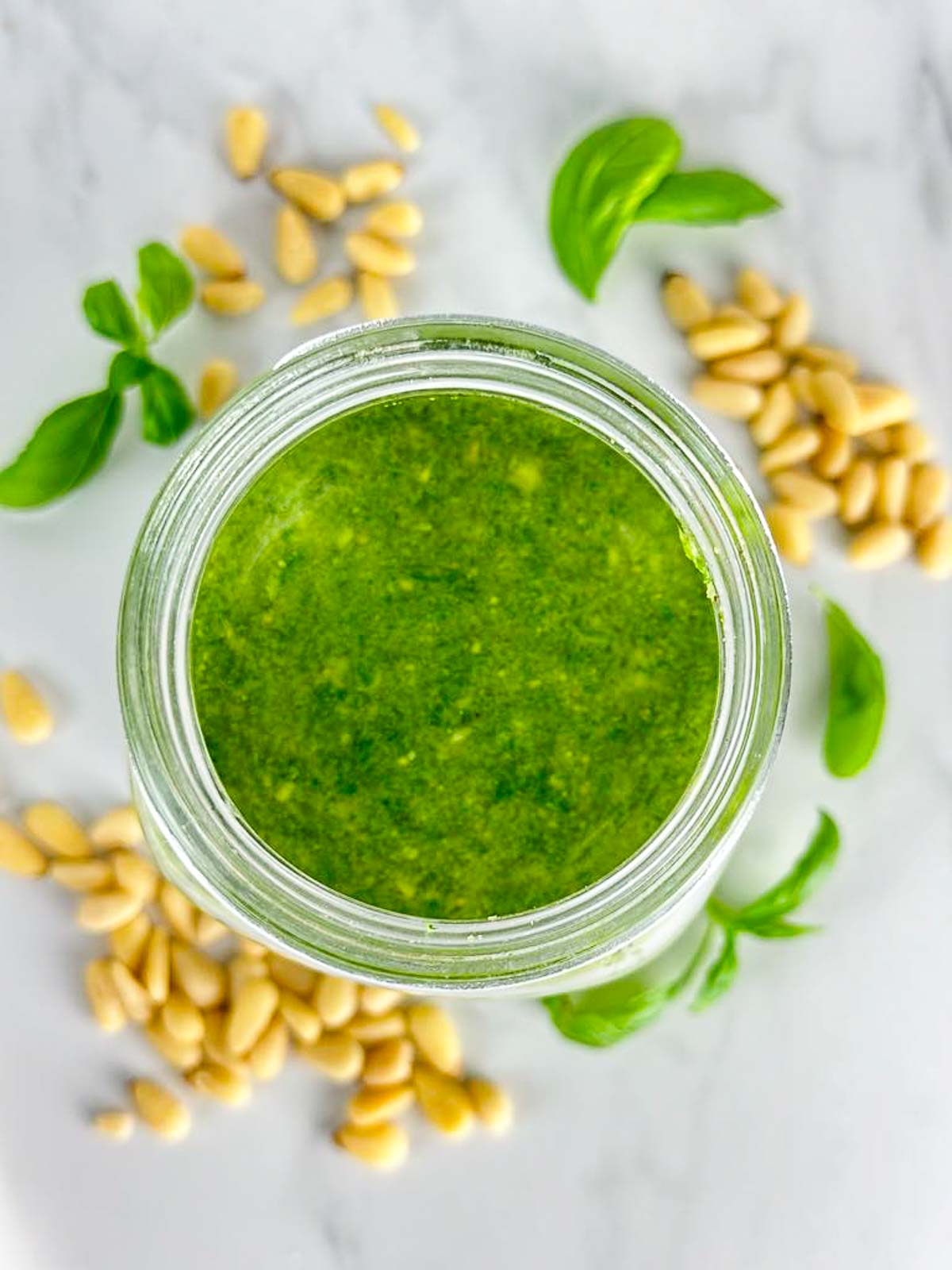Traditional Pesto Genovese Recipe
Pesto Genovese is made with simple, real ingredients and follows the traditional Italian recipe. The fresh flavors of pine nuts, fragrant basil, and garlic come together in this classic northern Italian sauce.

Post may contain affiliate links. As a member of the Amazon affiliate program, I may earn a small commision from qualifying purchases. To read my affiliate policy, click here.
I adore Italian food.
So many people think that because it tastes so good and packs so many robust, complex flavors that it has to be hard to make.
But it’s not.
It’s delightfully easy.
Recipes like this real Italian tomato sauce and this pesto Genovese are perfect examples.
They use only a few ingredients but the ingredients are fresh and fragrant and combined in just the right way to create magic.
And these days who doesn’t want a little extra magic in their life?
That’s what this pesto alla Genovese is.
It’s fragrant and bold and slightly spicy and salty and fruity and just *chef’s kiss* perfection.
And you only need 5 minutes to make it and it will totally knock your socks off.
It makes anything and everything taste amazing from gnocchi with pesto to pastas and salads.
Once you make homemade pesto alla Genovese, you’ll never go back to store bought again!
What is Pesto Genovese?

Pesto Genovese refers to the traditional way of making what Americans typically call pesto sauce with basil, garlic, pine nuts, and parmesan cheese.
It is also known as pesto alla Genovese or Genovese pesto.
“Pesto” is the past tense of “pestare,” which means “to crush.”
“Alla” translates to “in the style of,” and Genovese refers to a northern Italian city, Genoa, in the Liguria region, which is an area in northeastern Italy famed for the Italian Riviera and places like Cinque Terre and Portofino.
So pesto alla Genovese roughly means “crushed in the style of Genoa.”
Fun fact: pesto sauce could refer to any sauce that uses crushed ingredients.
Pesto Genovese is just one type of crushed sauce that happens to be the most famouse of them all.
This traditional recipe is based on crushed basil, pine nuts (which are plentiful in the Liguarian region), and garlic.
Ingredients and Kitchen Supplies

Here’s what you need to make pesto alla Genovese:
- Fresh basil – We often grow our own in our kitchen or front stoop. We get our plants from local growers or seasonally from stores like Lowes or Home Depot. You can also get fresh basil at most local grocery stores in the produce section. Ours also offers live plants most of the year.
- Garlic – Fresh garlic cloves help give the pesto sauce a bite. You can add more if you like or reduce the amount we use for a bit less intense flavor.
- Extra virgin olive oil – You could use other forms of olive oil, but we don’t recommend using other oils as they can change the flavor.
- Parmesan cheese – Traditional pesto sauces use Parmesan cheese, but you could sub in Romano cheese. We highly recommend getting authentic Parmigiano Reggiano (it’s more expensive but adds some extra layers of flavor), but you can use Parmesan cheese made in the United States. It will work with no major issues.
- Pine nuts – Pine nuts aka pignoli nuts give a mildly nutty, buttery flavor to the pesto sauce. We have another pesto sauce using walnuts if you want a variation that is very similar, but for an authentic flavor, use pine nuts.
- Salt and pepper – If you like, you can add about 2 pinches of salt and pepper to the sauce to help the flavors pop a bit more. You can also omit these with no major loss in flavor.
For kitchen gadgets, you will want to have on hand:
- Food processor – A good food processor chops up all the ingredients and creates the pesto sauce quickly.
- Mortar and pedestal – For the most authentic experience, you will want to break out a mortar and pedestal so you can crush your own pesto sauce using your own strength and grit. Sure, you might be a bit sore the next day, but your feelings of self-satisfaction will carry you through.
- Measuring cups – You probably have these on hand, but it makes it incredibly easy to measure out ingredients with measuring cups. Otherwise, you will have to channel your inner Italian grandmother who will whisper when you have added enough if you listen.
How to make Pesto Genovese
1. Make a paste.

Add the pine nuts, fresh basil, garlic, and Parmesan cheese to the bowl of your food processor.
Pulse the ingredients together.
Keep pulsing until a paste free from any large chunks forms.

To help make the sauce consistent, you may want to chop in half or quarter larger garlic cloves before blending them together.
2. Stream in the oil..

Once you have a consistent paste, pulse your food processor while slowly streaming in the extra virgin olive oil.
You will want to add enough to form a bright green, mostly smooth sauce that looks a little creamy.
The sauce should be somewhat liquidy so it easily coats pasta.
Depending on how densely you pack the basil leaves when you measure them and how thick you like your Genovese pesto, you’ll wind up using between 3/4 to 1 cup of olive oil.
How to Pick the Best Basil for Pesto
You can buy a big bunch of pre plucked basil in the produce section of the grocery store.
If you are buying a bunch, look for bright green leaves that don’t have brown or yellow spots and are not too big.
If, like us, you grow basil in your garden, look for smaller leaves on the plants that have not yet flowered.
These will give you the best flavor and be sweeter.
Basil that has gone to flower will be bitter.
In the real world, it can be difficult finding basil leaves that are on the small side, so we often pick any leaf that is free from yellowing or other damage.
But if the absolute freshest flavor is your goal, then make sure to pick the smaller leaves and only use those.
Making Ahead and Storing

Pesto Genovese is best served freshly made, but you can make it ahead and serve it when needed.
To store, spoon or pour the finished pesto sauce into a mason jar or other container with a lid.
It will keep fresh for about 2 weeks in the fridge.
You can also freeze it for about 6 months.
To serve, allow the pesto to come up to room temperature before tossing with your favorite pasta or using in your favorite recipe.
What to Serve with Pesto Genovese
There are so many things you can do with authentic pesto sauce!
Obviously tossing it with your favorite pasta like in this pasta al pesto recipe or toss it with this Easy Baked Gnocchi if you plan to serve it right away.
It’s also so good on salads in place of dressing like:
- Easy Pesto Caprese Salad
- a chilled Caprese Tortellini Pasta Salad
- in place of balsamic reduction on a Burrata Caprese Salad
- spooned over Easy Italian Grilled Chicken
Oh! And don’t forget sandwiches!
Use it as spread on this caprese baguette sandwich and this Easy Caprese Panini Sandwich with Pesto.
And let’s talk about things to drizzle it on or dip into it. Things like:
- Fried Mozzarella Grilled Cheese
- Easy Tortellini Caprese Skewers
- Elegant and Easy Prosciutto Caprese Skewers
- just a good piece of Italian bread!
Should I heat up pesto Genovese before serving?
No! Let the pasta or other dish heat up the pesto.
Unless a recipe specifically calls for pesto sauce to be added before cooking, like a baked dish, you generally do not want to add direct heat to pesto alla Genovese because:
- the basil can become bitter
- the garlic change flavor
- the sauce can separate
If you do store your sauce, just let it come up to room temperature so it heats up nicely when added to another recipe or pasta.
If you plan to use on a salad, as a dip, or on a sandwich, you may want to serve it straight from the fridge.
Tips and Tricks

- If the garlic cloves are really big, you may want to chop them down a bit. This can help create a more consistent paste.
- Garlic adds some heat and spiciness to to the pesto sauce. If you like it less spicy, use a bit less garlic. though you may have this strange feeling that my Grandma is made at you for this. For more heat, you can add more garlic, or if you want to break from tradition, add in some red pepper flakes.
- Before serving cold pesto sauce with hot pasta, let the pesto come back up to room temperature. This will allow the hot pasta to warm the pesto sauce up as you toss it together.
- If you notice your pesto sauce is too thick, you can add a little bit more olive oil. Add it a small amount at a time, remixing, and checking the consistency. Keep doing that until it reaches the consistency you like.
- If your pesto sauce is too thin, you can add a bit more parmesan cheese or pine nuts, a small amount at a time, mixing between adding more. Repeat adding more until it reaches the consistency you like.
- For a version of pesto with a bright citrusy flavor, try this lemon pesto sauce recipe!
Recipes to Use with Genovese Pesto
You can also use pesto sauce in other recipes, like:
- Easy Caprese Panini Sandwich with Pesto
- Pesto Chicken Burgers
- Easy Pesto Caprese Salad
- Quick Lemon Pesto Chicken and Orzo Skillet
- Chicken Spaghetti Pesto
- Easy Baguette Caprese Sandwich with Pesto
- Pasta al Pesto (Pesto with Linguine)
Did you make this? Let me know!
Did you make this pesto Genovese recipe or any other recipe on my site? Leave me a comment below and let me know how you liked it.
Make sure you follow along with me on Facebook, Pinterest and Instagram to see everything we’ve got going on.
Stay in the know! Sign up for our newsletter that contains the latest recipes and tips.

Equipment
- 1 Food processor You could use a high power blender if you prefer or a mortar and pedestal.
Ingredients
- 8 ounces fresh basil
- 6 cloves garlic
- 1.25 cups extra virgin olive oil
- 1/2 cup pine nuts
- 1/2 cup parmesan cheese
Instructions
- Pulse the Parmesan cheese, garlic, basil, and pine nuts in a food processor until a thick paste forms.8 ounces fresh basil, 1/2 cup pine nuts, 1/2 cup parmesan cheese, 6 cloves garlic
- While pulsing the food processor, slowly pour the olive oil into the paste until the paste reaches a sauce like consistency.1.25 cups extra virgin olive oil
- Season with salt and pepper to taste.
- Serve with your favorite pasta, sandwich, bread, or salad or use in your favorite pesto recipe.











